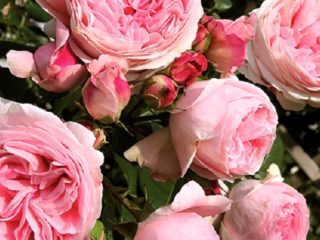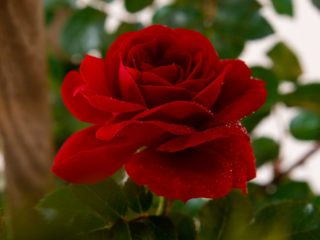Content
A miniature shrub covered with large flowers is the dream of many gardeners. And this is exactly the Lavender Ice rose, which can decorate any site. She amazes not only with the large size of the buds, but also with their lavender-lilac color, as well as an attractive aroma.
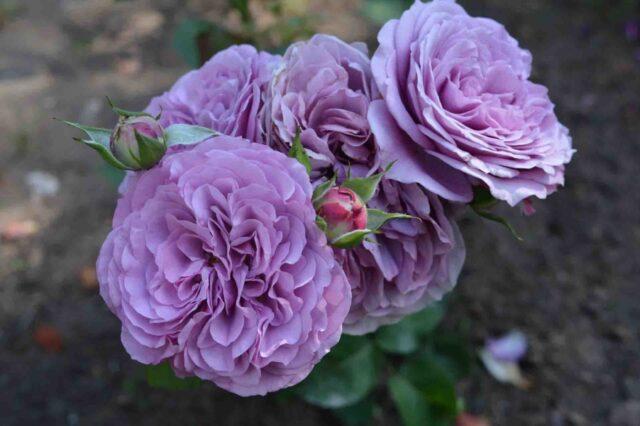
Rose Lavender Ice, due to its compact size, is more suitable for growing in the foreground in a flower bed
Breeding history
In 2008, as a result of the painstaking work of the German breeders of the Rosen Tantau company, an amazing plant was born that combines two seemingly incompatible qualities - these are miniature and impressive buds. And it was the Lavender Ice floribunda rose, which not only looks compact, but also has an original bud color. Its flowers of a delicate lavender shade in the sun shimmer with a bluish-silvery tone, which is why they gave it the name "lavender ice".
Description of Lavender Ice rose and characteristics
Rose Lavender Ice is not without reason referred to as miniature, because the height of the bush occasionally goes over 50 cm.Only with good care and favorable climatic conditions can you find a plant that has reached 1 m.It grows up to 60 cm wide.
There is a moderate amount of green mass, while the leaf plates are not large, but with a pleasant olive tint. The edges are slightly serrated and the leaf surface is glossy. Shoots are erect, strong, rosette-shaped apex. On one peduncle, from two to five buds are formed. Their shape is similar to a saucer, the diameter varies from 7 to 9 cm. The bush is especially beautiful at the peak of flowering, when the buds are in full dissolution. The outer petals have a light pale lilac shade, and the core is brighter purple. When burned out in the sun, the flower fades, acquiring a grayish-pink color with an ash tint. And, despite the fact that the Lavender Ice rose belongs to the floribunda group, it has a delicate and very attractive aroma.
Abundant flowering, often repeated. And the last wave occurs in autumn, while the flowers remain on the bush until the first frost.
The resistance of the bush to frost is quite high, it is also worth noting its immunity to powdery mildew and black spot. But to heavy rainfall, the rose shows a negative character. The petals fall off faster, the opening of the buds decreases.
In care, the Lavender Ice rose is unpretentious, but it is best not to ignore the standard growing rules so that the plant pleases with abundant and longer flowering.
Advantages and disadvantages of the variety
Like all garden flowers, the Lavender Ice rose has a number of advantages and disadvantages. Of course, this variety has many times more positive sides, which attracts many rose growers, both experienced and beginners.

The name of the Lavender Ice rose does not contain the word "Ice" for a reason, as it tolerates low temperatures well.
Pros:
- high survival rate of seedlings;
- the possibility of growing in areas with unfavorable climates;
- beautiful buds in shape and color;
- pleasant unobtrusive aroma;
- abundant and undulating flowering before the onset of cold weather;
- unpretentious care;
- frost resistance;
- high resistance to diseases and pests.
Minuses:
- small height of the bush, which limits its use in the landscape;
- in rainy weather, the buds open more slowly.
Reproduction methods
Since the Lavender Ice rose is a hybrid, only vegetative methods are used to propagate it, this allows you to preserve all the varietal characteristics of the plant. And the most common is precisely cuttings.
The cut of the Lavender Ice propagation material is performed from an adult bush after the first wave of flowering. The cuttings are chosen strong, their length should be about 10-15 cm. The cutting is carried out at a slope of 450 directly under the lower kidney, the upper cut is made straight 0.5 cm above the upper kidney. Then the cuttings are dipped into the biostimulator for about a day (the number of hours maintained depends on the type of preparation). After they are planted at an angle in fertile soil and sprinkled with sand. Be sure to perform a shelter from a film or plastic container.
Growing and care
The Lavender Ice rose seedlings are planted in late April, early May. Until that time, preparatory work must be carried out.
The key to the successful development of the plant will be the choice of the place for the future bush. It is best to give preference to an open area, but so that at noon the bush is located in partial shade, and the sun warms it up in the morning and evening hours. It is also advisable to protect the rose from through winds.
The ideal soil for the Lavender Ice variety is black soil. If loam predominates on the site, then the soil must be enriched with organic fertilizers. In this case, the acidity should be at a low level, the ideal will be in the range of 6-6.5 PH. It is possible to reduce its indicator with the help of lime or ash.
After planting the Lavender Ice roses, timely watering is carried out. This variety loves moisture, so the soil must be poured at least once a week at the rate of 10-15 liters per bush. If the weather is dry, then the amount of irrigation should be increased to twice a week.
After watering, be sure to loosen the soil and weed around the bush. These procedures will provide better aeration and prevent the appearance of diseases that can provoke weeds.
After planting, for the first 1-2 years, the Lavender Ice rose can not be fed, after which it is worth paying more attention to fertilizing the soil. It is best to make the introduction of nitrogen-containing complexes in the spring, and in the summer you can limit yourself to potassium and phosphorus preparations.
Pruning is done about 3-4 times per season. As a rule, sanitary cleaning of the bush is carried out in spring and autumn, removing all frozen and dried shoots. In the summer, only faded buds are removed.
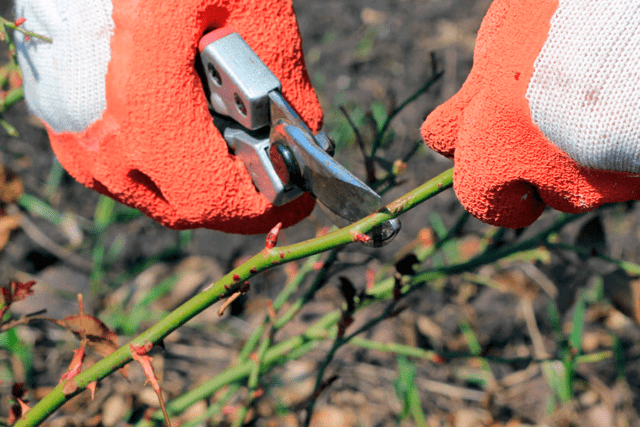
An adult Lavender Ice rose bush has a period of swelling of the buds, they cut off all the buds that are forming so that the plant gains more strength
It is necessary to cover the rose if the winter is very frosty and long. For this, spruce branches and non-woven material are used. First, they make sanitary autumn pruning, then they spud the bush with soil, then they install the frame and cover it with a film. Be sure to make several holes (air vents) for ventilation. From the end of March to mid-April, temporary removal of the covering material is performed to ventilate the plant, and with the onset of stable warm weather, the insulation is removed altogether.
Pests and diseases
Many gardeners appreciate the Lavender Ice variety because of its high immunity. It is especially resistant to the appearance of powdery mildew and black spot. But it has an average resistance to rust, therefore it needs preventive measures.And when this ailment appears, the affected areas must be removed and treated with fungicides (Topaz, Bordeaux liquid). As a prophylaxis, folk remedies are used, for example, soap solution or tincture on nettle, wormwood.
Also, with excessive watering, you can face such ailment as root rot. In this case, the moistening of the earth should be stopped immediately. Sometimes a rose transplant is required at all with the removal of the affected areas.
Among pests, aphid colony is especially dangerous. A spider mite and a rose sawfly can also attack a bush. Insecticides will help get rid of these harmful insects.
Application in landscape design
The compact Lavender Ice rose is most often used by landscape designers to decorate flower beds in the foreground. It goes well with many garden plants that bloom in delicate and brighter tones.
Due to its diminutive size, Lavender Ice is planted along curbs, in elevated areas and even in containers.
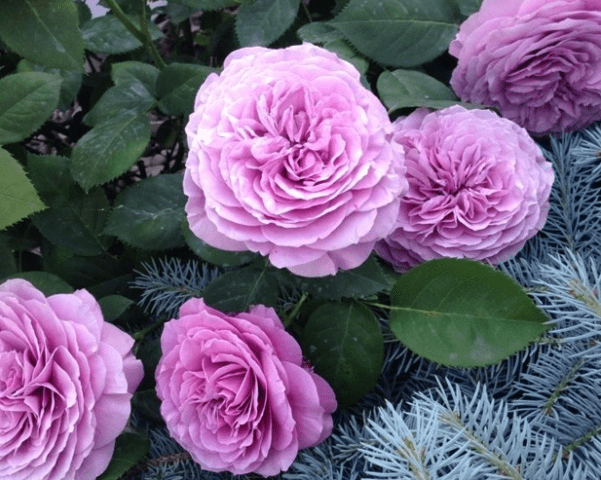
Thorny rose bush Lavender Ice feels good when planted among conifers
Conclusion
Rose Lavender Ice is distinguished by excellent decorative qualities, unpretentiousness and high resistance to a number of common diseases. It is these qualities that make this small shrub in demand among experienced and even novice rose growers. When creating all the necessary conditions for a garden plant, Lavender Ice will delight you with its beautiful lavender-lilac flowering for many years.
Reviews about Lavender Ice rose

